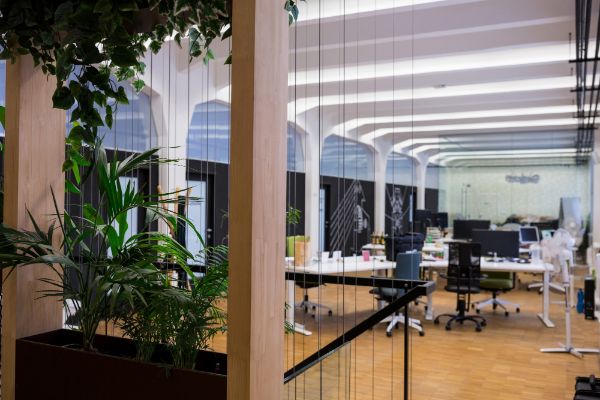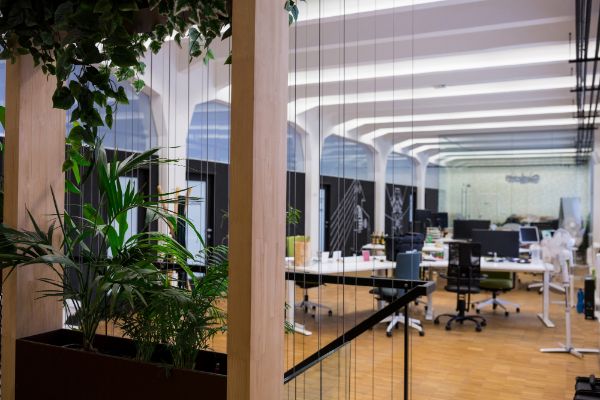
Are you tired of spending long hours at a workspace that feels like a dungeon? Do you constantly struggle to stay motivated and productive in an uncomfortable environment? If so, you are not alone.
As per the latest Gallup report, more than half of employees (51%) are disengaged in their workplace, while 13% are actively disengaged, which means they feel miserable at work. The good news is that this number decreased from 85% in 2017, a trans that lasted more than a year. This finding highlights that a workspace that lacks comfort and amenities can be a significant turn-off for employees and hinder their performance.
On the other hand, a well-designed workspace that considers employees’ needs and preferences can do wonders for their productivity, creativity, and overall job satisfaction.
Whether you’re a business owner, manager, or employee, you will get the tips and insights we’ll share on creating a comfortable workspace and fostering productivity.
So, grab a mug of coffee and join us as we venture to transform your workspace into a comfortable and inviting environment for employees!

Image by peoplecreations on Freepik
Why Is a Comfortable Workspace Important for Employees?
Most employees spend significant time at their desks, so providing a workspace that promotes their well-being is essential.
A comfortable workspace can-
- Increases Productivity
- Boosts Morale
- Improves Employee Satisfaction
- Reduces Absenteeism
- Enhance Creativity
The Key Elements for a Comfortable Workspace to Promote Employee Satisfaction
Now that we know the importance of having a comfortable workspace, let’s dive into the key elements that contribute to making a workspace comfortable.
On-desk jobs can significantly hamper your posture and may lead to other health issues. Studies have proven that long hours of desk work might increase the risk of spondylitis, osteoarthritis, and whatnot.
Ergonomic furniture supports your body’s natural movement and prevents physical strain. This includes chairs providing proper lumber support, desks, and even computer screens that can be adjusted to a correct height, preventing neck strain.
Investing in such types of furniture can help prevent injuries and increase comfort levels among employees.
-
Offer Ergonomic Accessories
In addition to ergonomic furniture, employers can offer ergonomic accessories such as keyboard trays, wrist rests, and monitor stands to promote good posture and reduce the risk of strain injuries.
Lighting is a crucial element of any workspace. Proper lighting can help prevent eye strain, headaches, and fatigue while improving overall mood and productivity. Natural lighting is ideal, but if that’s not possible, overhead lighting should be bright enough to avoid eye strain. But remember, it should not be too bright to cause glare.
Temperature control is another key element of a comfortable workspace. The temperature should not be too hot or cold, but just right. Keeping your workspace at a comfortable temperature can help reduce employee distraction and discomfort.
Amenities such as coffee machines and comfortable seating areas can make the workspace more pleasant and inviting by promoting social interaction and collaboration among employees.
Extreme noise can be distracting and uncomfortable for employees. Providing noise-reduction tools such as soundproof walls, acoustic panels, or noise-cancelling headphones can help employees concentrate and work more efficiently.
Personalization is essential in creating a comfortable workspace. Employees should be able to personalize their workspace with photos, plants, or other items that help them stay motivated, feel comfortable, and engaged.
A clean workspace is comfortable to work in, whereas a cluttered and messy workspace can be distracting and agonizing. Encourage employees to keep their workspace clean, clutter-free, and organized to minimize distractions and increase employee satisfaction.
Tips for Creating a Comfortable Workspace for Your Employees
Merely understanding the key elements is insufficient to craft your staff’s relaxing and comfortable workspace.
Therefore, we have compiled a list of our top suggestions to assist you in achieving this goal.
Before making any changes to the workplace, getting feedback from your employees is essential. Gather feedback on what aspects of their working space they enjoy and what they find unsatisfactory, as well as any desired modifications.
Colours can have a significant impact on someone’s mood. Consider using colours that promote productivity and creativity, such as blue or green.
-
Create Relaxation Spaces/Break Areas
Creating relaxation spaces or break areas can help employees to relax, de-stress and feel recharged during the workday. Employers can provide a designated relaxation area with comfortable seating, dim lighting, and soothing music.
Also, consider providing snacks or games to help employees to take a mental break.
Incorporating nature into the workspace can help reduce stress and improve employee well-being. Employers can consider adding plants or installing a living wall to bring nature indoors.
Offering flexibility in the workspace can help employees feel more comfortable and engaged. Employers can consider offering flexible work hours or remote work options to accommodate different employee needs.
The layout of the workspace can significantly impact employee comfort and productivity. Ensure the workspace is well-organized and employees have enough space to move around comfortably.
Consider providing standing desks or alternative workstations to promote movement and reduce physical strain.
Providing adequate storage can help reduce clutter and create a more organized workspace. Employers can provide filing cabinets, shelves, or drawers for employees to store their belongings.
Encouraging collaboration can promote employee engagement and job satisfaction. Employers can consider providing common areas for team meetings or collaborative projects.
By incorporating these additional tips, employers can create a workspace that promotes comfort and encourages productivity, creativity, and collaboration among employees.
Safety is the most crucial element for employee comfort and well-being. Ensure that the workspace is free of hazards and all equipment is regularly inspected and maintained. You can also provide safety training and equipment as needed.
-
Create a Positive Work Culture
A positive work culture can also help create a comfortable workspace. Encourage open communication, recognize employee achievements, and provide opportunities for growth and development.
Supported and valued employees are more likely to be satisfied with their workspace and job.
The Bottom Line
A comfortable workspace is not only about physical comfort but also promotes mental comfort and reduces stress, increasing productivity and job satisfaction. So, take the time to assess your workspace and implement these tips to create a comfortable and productive environment for your employees.
By prioritizing employee comfort, you can create a workplace culture that values and supports your employees, increasing retention, motivation, and success.
So, what are you waiting for? Start making changes to create a comfortable workspace today and see its positive effect on your employees and your business.
Looking For HR Management System?
Call Pursho @ 0731-6725516
Telegram Group One Must Follow :
For Startups: https://t.me/daily_business_reads




